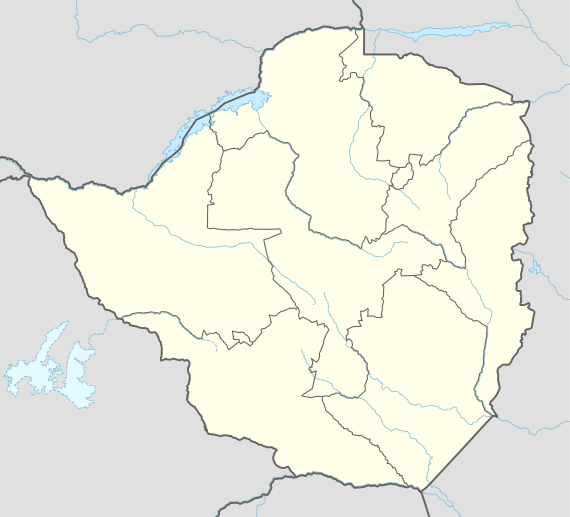Epworth, Zimbabwe
Coordinates: 17°53′22″S 31°09′41″E / 17.88944°S 31.16139°E
| Epworth KwaChiremba | |
|---|---|
| township | |
| Nickname(s): Epaz, Epaton | |
 Epworth | |
| Coordinates: 17°53′24″S 31°8′51″E / 17.89000°S 31.14750°E | |
| Country | Zimbabwe |
| Province | Harare Province |
| Established | 1929 |
| Government | |
| • Type | Local Board |
| Elevation | 1,473 m (4,833 ft) |
| Population (2012 census) | |
| • Total | 152,116 |
Epworth is a settlement in south-eastern Harare Province.
Background
Epworth is located about twelve kilometres from the Harare city centre. It is a high-density dormitory town administered by the Epworth Local Board.[1] It is bisected by a stream into two parts. The Balancing Rocks found in the northern approaches of the town are famous, and are featured on all bank notes issued by the Reserve Bank of Zimbabwe.
History
Epworth Mission was established by the Rev. Shimmin as a Methodist Mission Station more than a century ago, in 1890. Epworth then and to this day is divided into 7 wards: A large influx of people occurred during the late 1970s and early 1980s with the population being 20,000 in 1980 and 35,000 in 1987. The Methodist Church could not control the influx of people, and therefore transferred ownership of the farm to the Ministry of Local Government in 1983. By 2002 the population was 113,884.[2] Epworth had not been planned as an urban residential area, and therefore this rapid increase in population was occurring on land without any water supply or sanitation facilities. Epworth became the only informal settlement to have been tolerated by the Zimbabwean Government in the post-independence period because of the long history of settlement by some of the residents.[3] The government decided to upgrade rather than demolish the informal settlement. Since most residents of Epworth had settled in the area spontaneously, public utilities such as water, sewage and electricity were lacking before government intervention. A Local Board formed in 1986 under the Urban Councils Act, and whose members are elected by the community, is responsible for managing the area including the collection of rates and other levies.[4] Epworth was initially developed into four sub-areas but as the population increased it expanded to nine sub-areas that had extensive squatter settlements. Health services are provided by two clinics in the area. Also, in Epworth there is a large rock that the people call "Domboramwarwi", which means rock of God.
Development status
Electricity is mostly found at service centres, some schools, offices and most of the western suburbs including Stopover, Chinamano and OverSpill. The majority of residents get by as street vendors and informal manufacturers. There are no street names but most of the plots are numbered. The community is divided into suburbs that are demarcated by dust roads. Major suburbs include Chiremba, Stopover, Chinamano, Dam, Zinyengere, Pentagon, Magada, Overspill, Maulana, Donhoro, Munyuki, and Danastein. It is a poor suburb.[5] There are three secondary schools, namely Epworth High School, Domboramwari High School, and Muguta Secondary School which was commissioned in 2007.
Since most of the houses found in the town are built from unburnt bricks, the houses are prone to falling during heavy rains.[6]
Social decline
Due to the harsh economic times that the country has been passing through for the past decade, crime has been on the increase in the overcrowded suburb.[7] The historical numbers of crime in Epworth have always been far lower throughout its existence than now.[8] This has so grown into a problem that no one will address it except the government of Zimbabwe.
Artists Epworth has been the origin of numerous musical artists. Among some of them are Tapiwa Bulinda, Buju Bruce, Young Worrior, Chiketsiya, Kapfupi, Teaspoon, Ronald Chitiyo, kudakwashe warikandwaa and owen matikwa.
References
- ↑ Harare Provincial Profile (PDF) (Report). Parliament Research Department. 2011.
- ↑ Central Statistics Office of Zimbabwe, 2003. Demographic and Healthy Survey, Government Printer, Harare, Zimbabwe.
- ↑ Butcher, 1993 C. Butcher, Low income housing. In: L. Zinyama, Editor, Harare—The Growth and Problems of the city, University of Zimbabwe Publications, Harare, Zimbabwe (1993)
- ↑ Gandidzanwa, P., 2003. Attitudes and practices towards water supply and sanitation facilities: the case study of the Epworth upgrading programme. M.Sc. thesis (unpublished), University of Zimbabwe
- ↑ Heavy rain sometimes destroy homes (accessed 2 November 2008)
- ↑ Relief Work continues (accessed 2 November 2008)
- ↑ No respite for workers.(accessed 2 November 2008)
- ↑ "Epworth Turns Back on Its Christian Roots" at allafrica.com (accessed 2 November 2008)